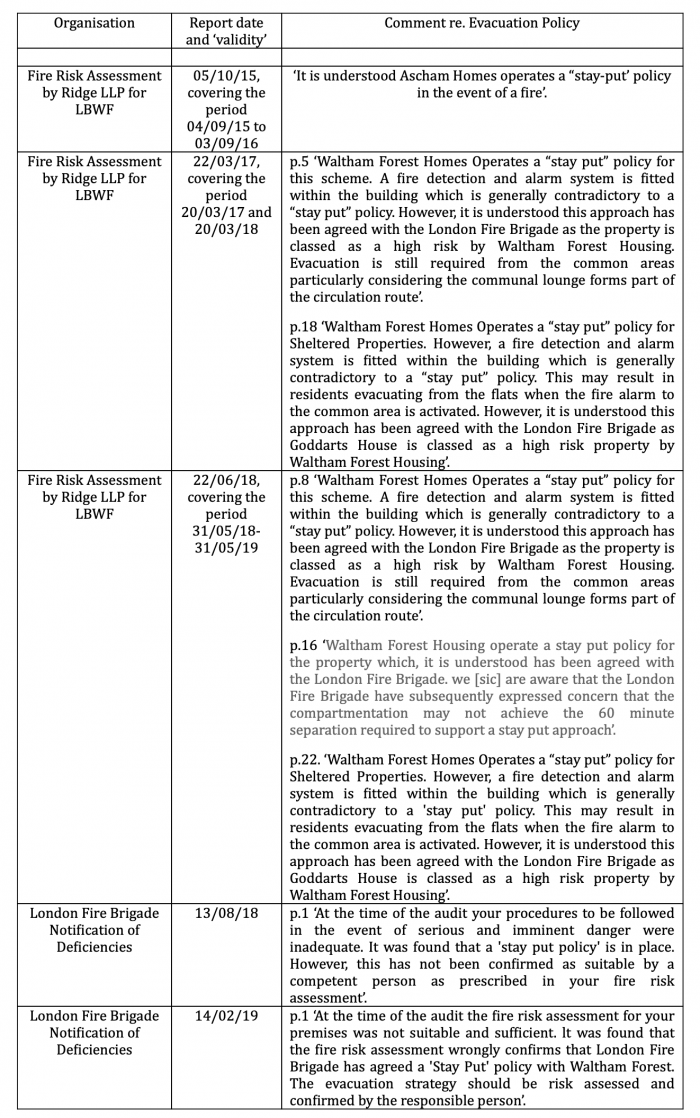Goddarts House sheltered housing in Walthamstow: new facts, new controversy
Reproduced below is a letter that I yesterday sent to LBWF Chief Executive Martin Esom which focuses on some new material that has emerged about fire safety measures at Goddarts House sheltered housing in Walthamstow.
The first issue raised with Mr. Esom is about the London Fire Brigade’s recently divulged claim that it was misrepresented in one or more of LBWF’s pre-2019 Fire Risk Assessment (FRA) reports on Goddarts, specifically, ‘wrongly’ recorded as having endorsed the long-standing ‘stay put’ policy for residents in the case of fire.
How could such a misrepresentation possibly have occurred, especially about something so important?
What follows in the letter turns to the most recent FRA reports at Goddarts.
These were compiled by a company acting as LBWF’s agent called S3Environmental, and consisted of, in 2019, a basic FRA Type 1 investigation, and, in 2020, a much more thorough and invasive FRA Type 4 investigation.
The key finding that emerges is that both these documents give the ‘date of inspection’ of the property as 8 August 2019, in other words the same day!
And this is particularly worrying because apart from the obvious fact that carrying out two FRAs at the same property on the same day makes little sense, the amount of work involved anyway precludes this from having happened. Indeed, adding to the mystery, it is doubtful whether S3Environmental representatives attended Goddarts on 8 August 2019 at all. Visitors to Goddarts unsurprisingly have to sign in. There is no entry for S3Environmental on that particular date.
It is a universally accepted axiom that documentation about fire safety – especially at sheltered housing – must be faultless, because any imprecision, misrepresentation, or straightforward error, may have such grave consequences.
Yet at Goddarts, this axiom seems to have been cast aside.
Anyway, I will publish Mr. Esom’s no doubt fulsome reply when received.
One matter which is not included in the letter, but deserves scrutiny, is why sometime in 2019 LBWF jettisoned the previous company it employed to carry out FRAs at Goddarts, the experienced and distinguished Ridge and Partners LLP, in favour of S3Environmental.
For though little is known about the mechanics of S3Environmental’s appointment (investigations continue) on the face of it, at least, the company seems a surprising choice.
S3Environmental is a small outfit based in Worsley, Manchester, which introduces itself on its website as an asbestos management consultant, without mention of fire safety at all:
 Turning to Companies House reveals that S3Environmental is, anyway, not very successful, with a big loss in 2018-19 wiping out two previous years’ worth of modest profits, and producing negative net assets:
Turning to Companies House reveals that S3Environmental is, anyway, not very successful, with a big loss in 2018-19 wiping out two previous years’ worth of modest profits, and producing negative net assets:
The company also seems confused about the numbers it employs, stating in its Companies House submissions that the total is two, but on LinkedIn boosting this to ’11-50’.
So the question is obvious.
In contracting its FRA work at Goddarts, why would LBWF ditch a tried and tested expert, Ridge, in favour of a small, Manchester-based, and financially not very successful asbestos management consultant?
Answers on a postcard, please.
3 June 2020
Dear Mr. Esom,
Fire safety at Goddarts House sheltered housing in Walthamstow
I am writing to you about some new material which has emerged about fire safety at Goddarts House – material that gives very serious cause for concern.
I take it as read that
(a) fire safety in sheltered housing is paramount, as residents therein are particularly at risk should a conflagration occur; and
(b) accordingly, related documentation must be faultless, because any imprecision, misrepresentation, or straightforward error, may have grave consequences.
You will know that the fire safety regime at Goddarts has already provoked controversy, primarily because of the revelation that though LBWF officers, the Cabinet portfolio holder, and the London Fire Brigade (LFB) all initially insisted the FEDs there gave 60 minutes protection, the true figure is presently said to be somewhere in the range 31 to 45 minutes (the indeterminacy is in itself deeply unsatisfactory).
Regrettably, the new material raises issues which are equally troubling, and can be summarised as follows:
- The Goddarts evacuation strategy
The table attached below reproduces what five official investigations – three by LBWF’s agent Ridge, and two by the LFB – concluded about the evacuation policy at Goddarts in the period 2015-19.
It shows that:
(a) the LBWF/Ridge Fire Risk Assessment reports of 2015, 2017, and 2018 all reported that the policy in the event of a fire was ‘stay put’;
(b) the LBWF/Ridge Fire Risk Assessment report of March 2017 twice repeated that ‘it is understood this approach has been agreed with the London Fire Brigade’;
(c) the LBWF/Ridge Fire Risk Assessment report of June 2018 again twice repeated that ‘it is understood this approach has been agreed with the London Fire Brigade’, while also registering some ‘subsequently expressed’ LFB concern as to whether compartmentalisation in the building was sufficient ‘to support a stay put approach’;
(d) the LFB Notification of Deficiency (NOD) of August 2018 reported that the ‘stay put’ policy had not been ‘confirmed as suitable by a competent person’; and
(e) the LFB’s Notification of Deficiency (NOD) of February 2019 reported: ‘It was found that that the fire risk assessment wrongly confirms that London Fire Brigade has agreed a “Stay Put” policy with Waltham Forest’ [emphasis added].
It is disturbing to discover that the LFB believed itself to be misrepresented about such a crucially important issue as ‘stay put’, so please will you explain how this possibly can have occurred? In addition, please will you state whether
before 2020 the LFB in fact ever advised either Ridge acting for LBWF, or LBWF directly, that ‘stay put’ was appropriate for Goddarts?
- Fire Risk Assessments at Goddarts in 2019 and 2020.
In recent weeks LBWF has released the two documents, one purporting to be a Type 1 Fire Risk Assessment of Goddarts carried out by S3Environmental in 2019, the other purporting to be a Type 4 Fire Risk Assessment of Goddarts carried out by S3Environmental in 2020.
According to these documents, each was based upon an inspection that occurred on 8 August 2019, that is, the same day.
Apart from the fact that carrying out two Fire Risk Assessments at the same property on the same day makes little sense, the amount of work involved anyway precludes this from having happened. Furthermore, if the 3SEnvironmental representatives really had attended Goddarts on 8 August 2019, they would have been told to sign the visitors’ book (because that is mandatory), but there is no such entry.
Again, given the crucial role that Fire Risk Assessments play, please will you explain (a) how the Fire Risk Assessments of 2019 and 2020 were really compiled, and when; and (b) why both LBWF officers and S3Environmental were apparently happy with the dating on the documents they signed off, despite the glaring discrepancy described?
Yours sincerely,
Nick Tiratsoo


